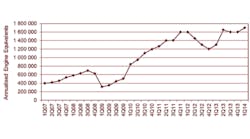Recently SinterCast AB reported its first-quarter results for 2014, including the news of new-record volumes of compacted graphite iron produced according to its process route. During the January-March period, CGI output rose 30% year-over-year to an annualized rate of 85,000 metric tons worldwide. During March, the annualized rate reached 87,500 metric tons, the second-highest monthly output ever for CGI produced by the SinterCast route.
Stockholm-based SinterCast is the world’s largest supplier of process control technology for producing compacted graphite iron, a lightweight alternative to gray iron and aluminum for automotive component manufacturing.
The company listed several factors for the increased level of production, including a 100% year-on-year increase in the volume of SinterCast CGI for commercial vehicle castings. Factors behind that increase appear to include the new Euro 6 standard for commercial vehicle emissions; the increase in CGI volume in some North American pick-up platforms; and the introduction of a CGI version of Ford Motor Co.’s V-6 gasoline engine program; and a forthcoming CGI V8 diesel engine from Nissan early in 2015.
SinterCast also noted the first quarter marked the start of series production by Tupy, in Brazil, of a CGI cylinder head for an industrial engine.
Tupy is among the largest-volume producers of SinterCast CGI, and adding industrial power products are part of its strategy to increase its CGI cylinder block and head output from the current 16% to 25% of the total.
SinterCast said new installations and technology updates continued during the first quarter, following record installation revenue in 2013. During January, SinterCast secured a new order for a System 3000 Plus from one of China's largest automotive parts manufacturers, to be installed at a greenfield CGI foundry in China. The equipment will be installed this summer.
SinterCast said it has ongoing discussions for other new installation, in Europe, Asia, and the Americas, and estimated that the combined potential of current series production programs and programs under development represents approximately 4.7 million “engine equivalents” (235,000 metric tons) per year within five years.
The group further estimated that current SinterCast CGI production programs have the potential for over 125,000 metric tons/year at full capacity.
SinterCast also reported that its ongoing development of a new process control technology for ductile iron production has been affected by the increased focus on CGI programs. However, it said the technical development continues and market opportunities remain available. In that light, SinterCast recruited a new senior research engineer to “expand and accelerate” its ductile iron technology development.
“The SinterCast ductile iron technology is expected to provide additional benefit to customers by reducing magnesium consumption, improving mold yield, and reducing casting defects in the foundry, and by improving machinability,” the group noted.









